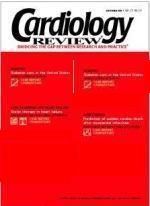Publication
Article
Cardiology Review® Online
Enalapril in atrial fibrillation
The study by Butnaru and colleagues (page 20) examined patients who participated in the Studies of Left Ventricular Dysfunction (SOLVD) trial, which looked at the use of enalapril in patients with left ventricular dysfunction. Over approximately 3 years, patients taking enalapril had a significantly lower risk of developing atrial fibrillation. There was an absolute risk reduction of 18.6% (24% in the placebo group versus 5.4% in the treatment group). This effect was more apparent in patients with fewer symptoms from their congestive heart failure (CHF). The authors conclude that enalapril reduces the risk of development of atrial fibrillation in patients with left ventricular systolic dysfunction.
This study is the first to suggest that angiotensin-converting enzyme (ACE) inhibitors can improve atrial fibrillation. Prospective studies are needed to validate this finding. Although we usually think of antiarrhythmic agents for the prevention of atrial fibrillation, this study implies that ACE inhibitors have antiarrhythmic properties. In order to understand this, we need to consider atrial remodeling.
The concept of atrial remodeling is encapsulated in the adage that “atrial fibrillation begets atrial fibrillation.” This was elegantly demonstrated by Wijffels and colleagues.1 In this study, atrial fibrillation was induced in goats with rapid atrial fibrillation. Initially, induced atrial fibrillation episodes were brief, similar to what we see clinically with paroxysmal atrial fibrillation. As atrial fibrillation was repeatedly induced, however, the episodes became longer, until they were persistent. The authors concluded that atrial fibrillation itself remodels the atria in order to better support the arrhythmia. Interestingly, the morphologic changes in the remodeled atrial myocytes resembled those of hibernating ventricular myocytes.2
More importantly, it appears that atrial remodeling is reversible. There are data to suggest that calcium channel blockers can attenuate the remodeling process.3-5 In addition, it appears that maintenance of sinus rhythm may also help reverse atrial remodeling.6,7 Finally, there are now data indicating that ACE inhibition may help to reduce this process. This is not surprising, since we routinely use ACE inhibitors to reverse ventricular remodeling.
In clinical practice, we must remember that the treatment of atrial fibrillation depends on the individual patient. Restoration of sinus rhythm is not necessarily superior to heart rate control. Prevention of atrial fibrillation may have advantages, however, especially in patients with left ventricular systolic dysfunction. This begs the question, should we prescribe ACE inhibitors for patients with atrial fibrillation who do not have CHF? Unfortunately, we have no data to help us here.
In this study, the increased effect seen in patients with less severe CHF suggests that the effects of ACE inhibitors on atrial remodeling are an important mechanism for prevention of atrial fibrillation. This suggests that those patients with atrial fibrillation without CHF would also benefit from ACE inhibition. In our patients with CHF, ACE inhibition is the standard of care. It remains unclear whether ACE inhibitors should be the standard of care for all patients with atrial fibrillation.
